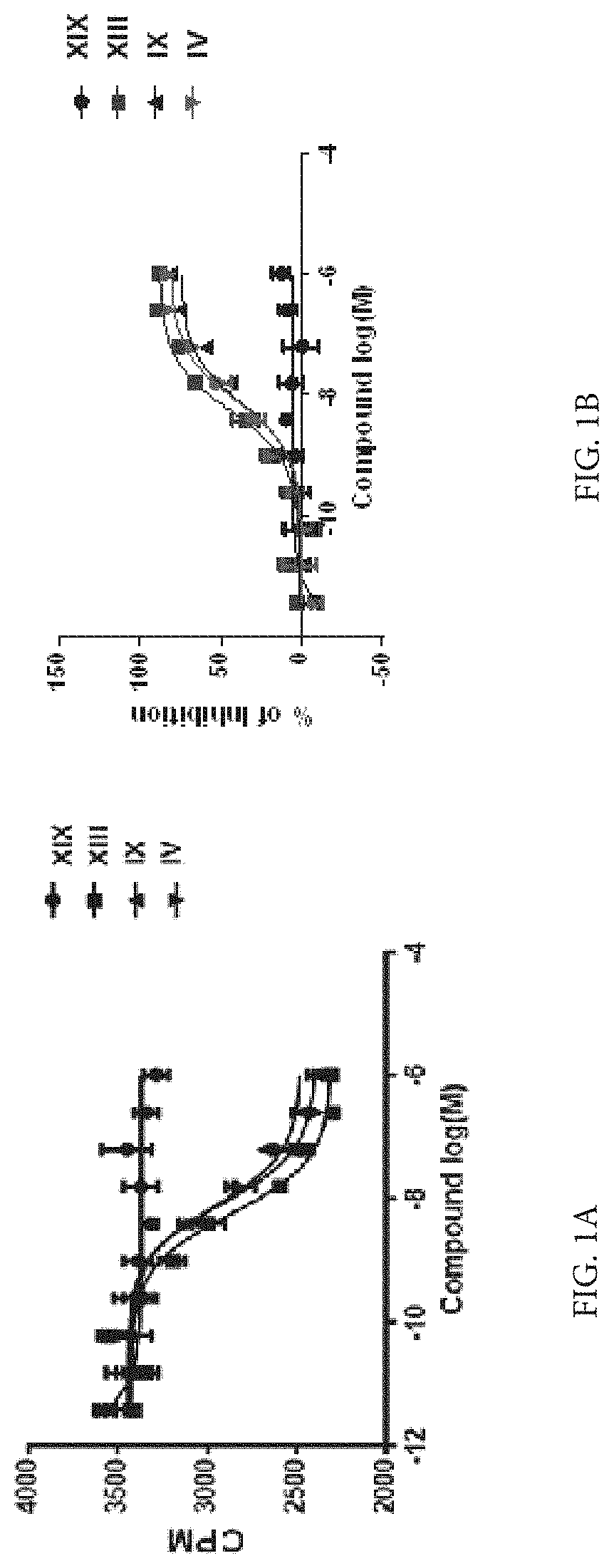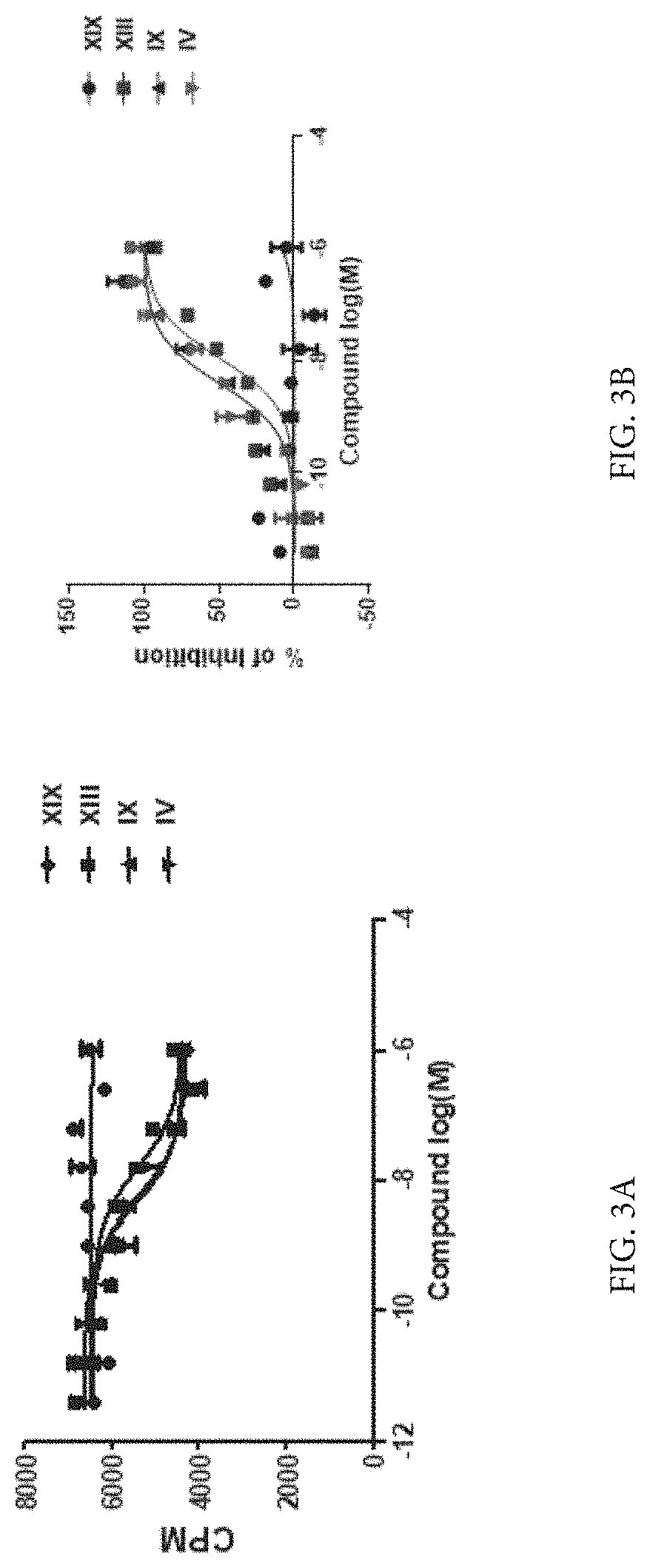Compounds as neuronal histamine receptor-3 antagonists and uses thereof
a technology of neuronal histamine receptor and antagonistic compound, which is applied in the field of compound as neuronal histamine receptor3 antagonist, can solve problems such as pharmaceutically unacceptable compositions
- Summary
- Abstract
- Description
- Claims
- Application Information
AI Technical Summary
Problems solved by technology
Method used
Image
Examples
example 1
2-methyl-3-(4-(3-(pyrrolidin-1-yl)propoxy)phenyl)-6-(pentafluorosulfanyl) quinazolin-4(3H)-one (I)
[0338]
Step 1: 2-(dichloromethyl)-1-nitro-4-(pentafluorosulfanyl)benzene (19)
[0339]To a solution of t-BuOK (8.1 g, 72.2 mmol) in dry DMF (60 mL) and THF (60 mL) was added a solution of 1-nitro-4-(pentafluorosulfanyl)benzene (18) (6.0 g, 24.1 mmol) and CHCl3 (3.0 g, 25.3 mmol) in DMF (30 mL) dropwise at −78° C. under N2 atmosphere. The reaction was stirred at −78° C. for 0.5 h and then quenched with aqueous HCl solution (2 M) until pH=4. The resulting mixture was diluted with water (200 mL) and extracted with EA (2×100 mL). The combined organic phase was washed with brine (100 mL), dried over anhydrous Na2SO4, filtered and concentrated. The residue was purified by column chromatography (silica gel, PE / EA=100:1) to afford the titled compound 19 (6.0 g, 75%) as a yellow oil. 1H-NMR (400 MHz, CDCl3) δ=8.56 (s, 1H), 8.09 (d, J=9.2 Hz, 1H), 7.96 (dd, J=2.0, 8.8 Hz, 1H), 7.52 (s, 1H).
Step 2: 2-...
example 2
(S)-2-methyl-3-(4-(3-(2-methylpyrrolidin-1-yl)propoxy)phenyl)-6-(pentafluorosulfanyl)quinazolin-4(3H)-one (II)
[0343]
Step 1: 1-(3-bromopropoxy)-4-nitrobenzene (24)
[0344]To a stirred suspension of 4-nitrophenol (23) (2.0 g, 14.4 mmol) in CH3CN (30 mL) was added 1,3-dibromopropane (5.8 g, 28.8 mmol) and K2CO3 (6.0 g, 43.2 mmol) at 25° C. The reaction was stirred at 80° C. for 16 h and then concentrated. The residue was partitioned between EA (20 mL) and water (10 mL). The organic phase was washed with brine (10 mL), dried over anhydrous Na2SO4, filtered and concentrated. The residue was purified by column chromatography (silica gel, PE / EA=10:1) to afford the titled compound 24 (2.1 g, 57%) as an off-white solid.
Step 2: (S)-2-methyl-1-(3-(4-nitrophenoxy)propyl)pyrrolidine (25)
[0345]To a stirred suspension of 1-(3-bromopropoxy)-4-nitrobenzene (24) (260 mg, 1.0 mmol) in CH3CN (4 mL) were added K2CO3 (276 mg, 2.0 mmol) and (S)-2-methylpyrrolidine (170 mg, 2.0 mmol) at 25° C. The reaction w...
example 3
3-(4-(3-(azepan-1-yl)propoxy)phenyl)-2-methyl-6-(pentafluorosulfanyl) quinazolin-4(3H)-one (III)
[0348]
Step 1: 1-(3-(4-nitrophenoxy)propyl)azepane (27)
[0349]To a stirred suspension of 1-(3-bromopropoxy)-4-nitrobenzene (24) (260 mg, 1.0 mmol) in CH3CN (4 mL) were added K2CO3 (276 mg, 2.0 mmol) and azepane (198 mg, 2.0 mmol) at 25° C. The reaction was stirred at 80° C. for 16 h and then concentrated. The residue was partitioned between EA (10 mL) and water (5 mL). The organic phase was washed with brine (5 mL), dried over anhydrous Na2SO4, filtered and concentrated. The residue was purified by column chromatography (silica gel, DCM / MeOH=10:1) to afford the titled compound 27 (217 mg, 78%) as a yellow oil. MS (ESI): [M+H+]=278.9.
Step 2: 4-(3-(azepan-1-yl)propoxy)aniline (28)
[0350]To a stirred suspension of 1-(3-(4-nitrophenoxy)propyl)azepane (27) (217 mg, 0.8 mmol) in MeOH (5 mL) was added Pd / C (20 mg, 10%) in one portion at 25° C. The reaction was stirred at 25° C. under H2 atmosphere ...
PUM
 Login to View More
Login to View More Abstract
Description
Claims
Application Information
 Login to View More
Login to View More - R&D
- Intellectual Property
- Life Sciences
- Materials
- Tech Scout
- Unparalleled Data Quality
- Higher Quality Content
- 60% Fewer Hallucinations
Browse by: Latest US Patents, China's latest patents, Technical Efficacy Thesaurus, Application Domain, Technology Topic, Popular Technical Reports.
© 2025 PatSnap. All rights reserved.Legal|Privacy policy|Modern Slavery Act Transparency Statement|Sitemap|About US| Contact US: help@patsnap.com



